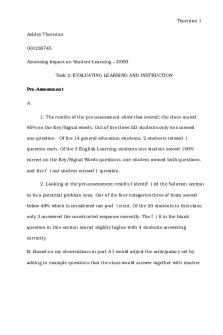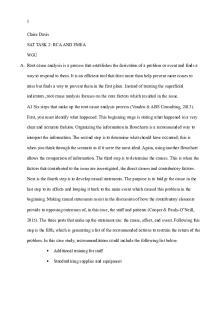Task 2 Cognitivism Constructivism PDF

| Title | Task 2 Cognitivism Constructivism |
|---|---|
| Course | Learning Theories |
| Institution | Western Governors University |
| Pages | 3 |
| File Size | 56.3 KB |
| File Type | |
| Total Downloads | 104 |
| Total Views | 144 |
Summary
Learning Theories Task 2...
Description
IZT Task 2: Cognitivism/Constructivism There are many key elements of cognitivism that could impact student teaching and learning. One is by studying how the mind works and retains information in the long term. Knowledge of information is processed in steps or stages (Snowman & McCown, 2015). There are no limits on the amount of information a student can retain, but it must happen over time. There are three memory sections; sensory, short-term, and long-term learning. Also, different tasks will use different parts of the brain. Educators who are aware of these three elements of cognitivism will help teach students more effectively. Teachers can use this information to plan engaging and effective lessons. Students use multiple learning avenues to store information in their long term memory.
In my lesson plan, I would modify the independent activity to align with the Cognitivism theory. In the independent activity, students would choose how they would like to complete the assignment. Options may include for students to orally stating what and why they think the phrase is nonliteral and literal. Students are able to move around the setting and sit where they learn best to activate different parts of the brain. This connects to the theory because students will use different modalities to learn which will activate different parts of the brain. This will help store the information for the longterm. Students will also recall information throughout the year to maintain the information that was learned. The strengths of changing the lesson plan to the cognitivism theory would help students retain information for years to come. Another strength would be students will have the foundation of the skill and can work on deepening understanding of the skill build on prior knowledge. One of the weaknesses of this theory is that it’s nonobservable and cannot be measured (Snowman & McCown, 2015).
The three key elements of constructivism that could impact teaching and learning are making learning meaningful, seeking to understand people, and being able to make
sense of the world through discovery. Specifically, making connections to real-world scenarios and using experiments to test their hypotheses are two examples of how the key elements of constructivism impact both teaching and learning. Exploring and learning through experiences from the past to the present would be beneficial to students.
The Constructivism theory believes that students learn through doing. I would align my lesson plan to this theory by having students create and design 3-dimensional construction and art demonstrating both literal and nonliteral meanings. I would let them play with their 3-dimensional art and present it to the class. In addition, students would explain why it is important to know the difference between the literal and nonliteral meanings of phrases and words. All students have different prior knowledge so all lessons would have to be differentiated for each individual student in the class. Students can be grouped to accomplish this task. This would be time-consuming and difficult to be consistent in the long term in the classroom. A positive outcome of the theory being implemented would be that students would find learning engaging.
Reference List
Snowman, J., & McCown, R. R. (2015). Psychology applied to teaching. Australia: Cengage learning....
Similar Free PDFs

Non Cognitivism Essay
- 6 Pages

M2 constructivism
- 4 Pages

Task 2 - Task 2
- 5 Pages

QHT1 Task 2 - Task 2
- 1 Pages

Task 2 - C226 Task 2
- 7 Pages

D082 Task 2 - Task 2
- 3 Pages

TDT1 Task 2 - Task 2
- 4 Pages

TET1 Task 2 - Task 2
- 4 Pages

DO81 - Task 2 - Task 2
- 5 Pages

C228 Task 2 - Task 2
- 6 Pages

D081 - Task 2 - Task 2
- 2 Pages

D093 Task 2 - task
- 6 Pages

Final CPC TASK 2 - task 2
- 44 Pages

Task 2
- 8 Pages
Popular Institutions
- Tinajero National High School - Annex
- Politeknik Caltex Riau
- Yokohama City University
- SGT University
- University of Al-Qadisiyah
- Divine Word College of Vigan
- Techniek College Rotterdam
- Universidade de Santiago
- Universiti Teknologi MARA Cawangan Johor Kampus Pasir Gudang
- Poltekkes Kemenkes Yogyakarta
- Baguio City National High School
- Colegio san marcos
- preparatoria uno
- Centro de Bachillerato Tecnológico Industrial y de Servicios No. 107
- Dalian Maritime University
- Quang Trung Secondary School
- Colegio Tecnológico en Informática
- Corporación Regional de Educación Superior
- Grupo CEDVA
- Dar Al Uloom University
- Centro de Estudios Preuniversitarios de la Universidad Nacional de Ingeniería
- 上智大学
- Aakash International School, Nuna Majara
- San Felipe Neri Catholic School
- Kang Chiao International School - New Taipei City
- Misamis Occidental National High School
- Institución Educativa Escuela Normal Juan Ladrilleros
- Kolehiyo ng Pantukan
- Batanes State College
- Instituto Continental
- Sekolah Menengah Kejuruan Kesehatan Kaltara (Tarakan)
- Colegio de La Inmaculada Concepcion - Cebu

